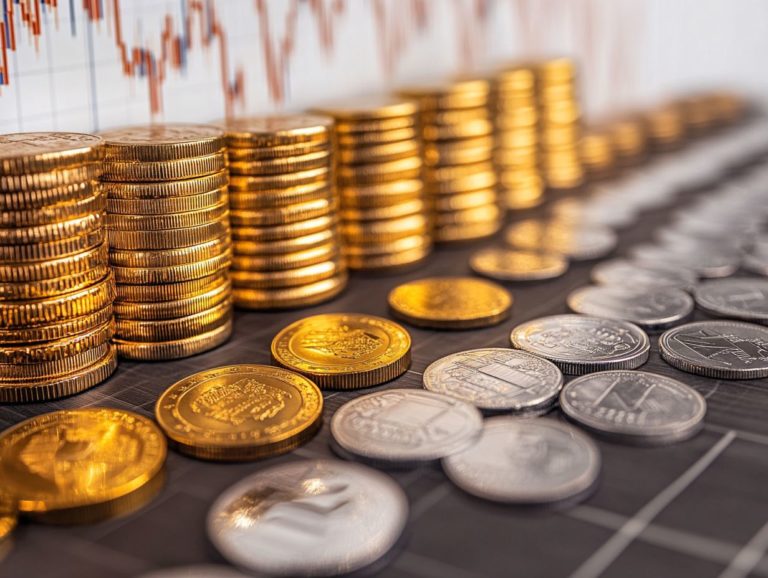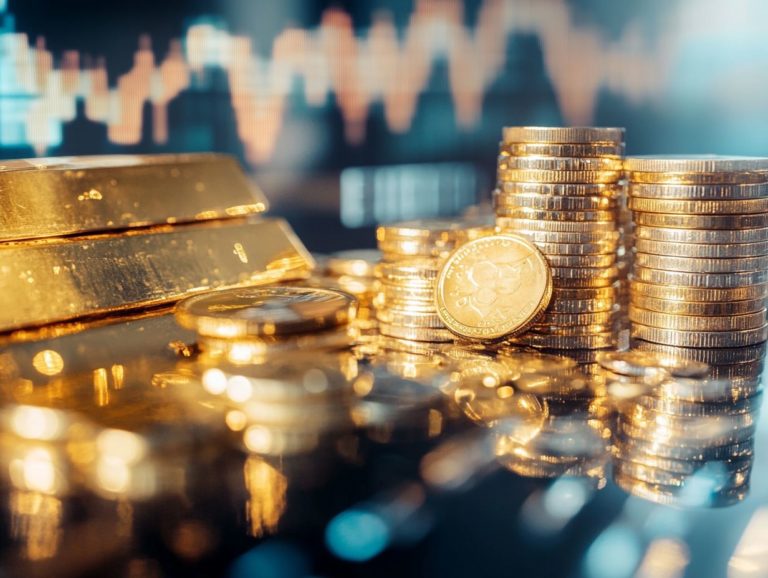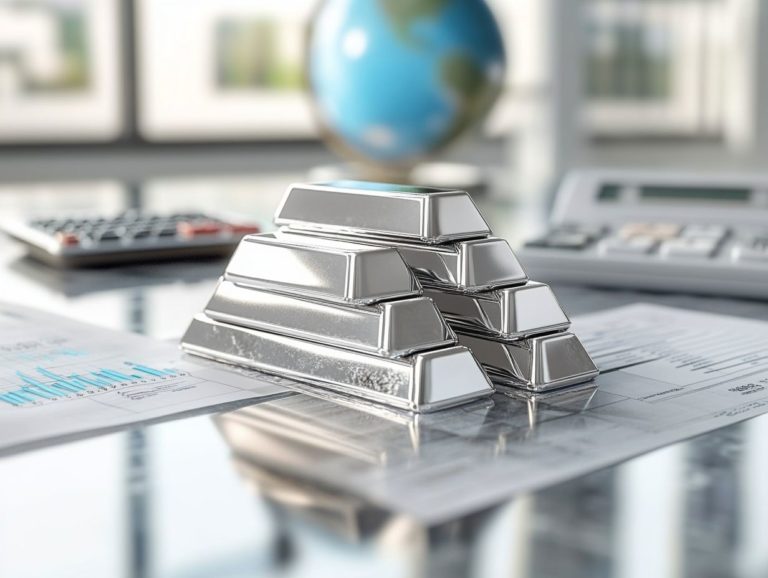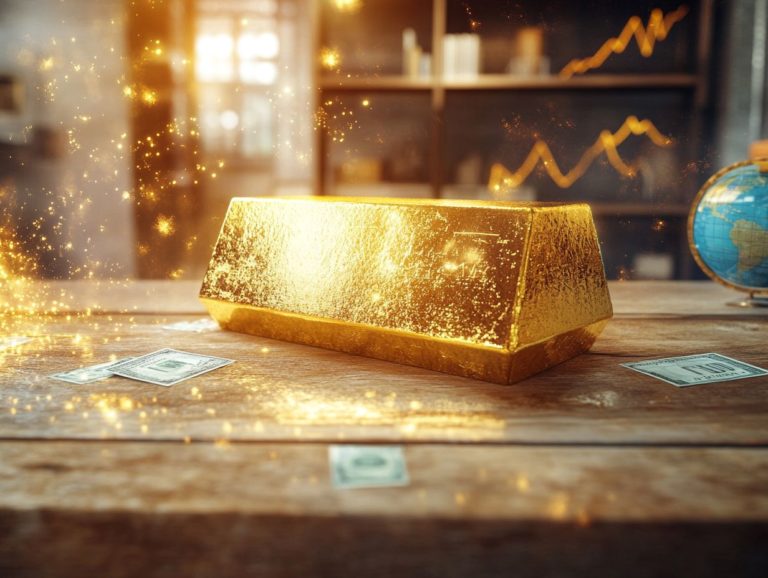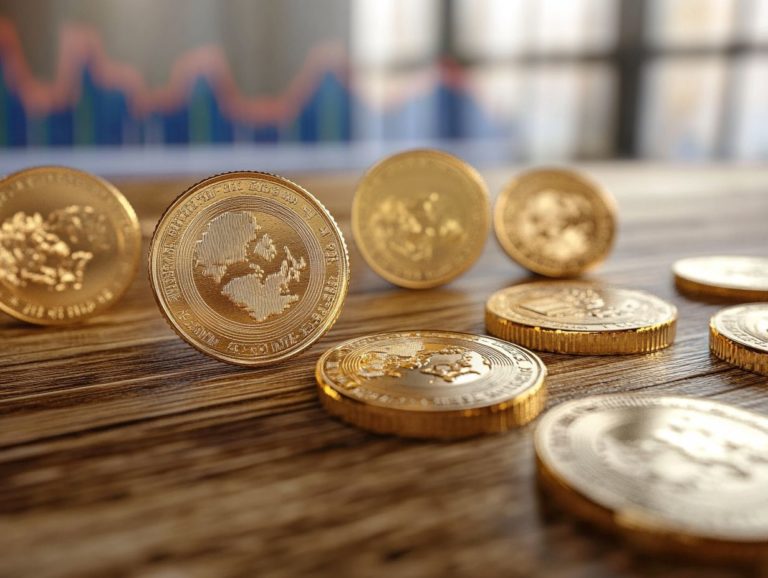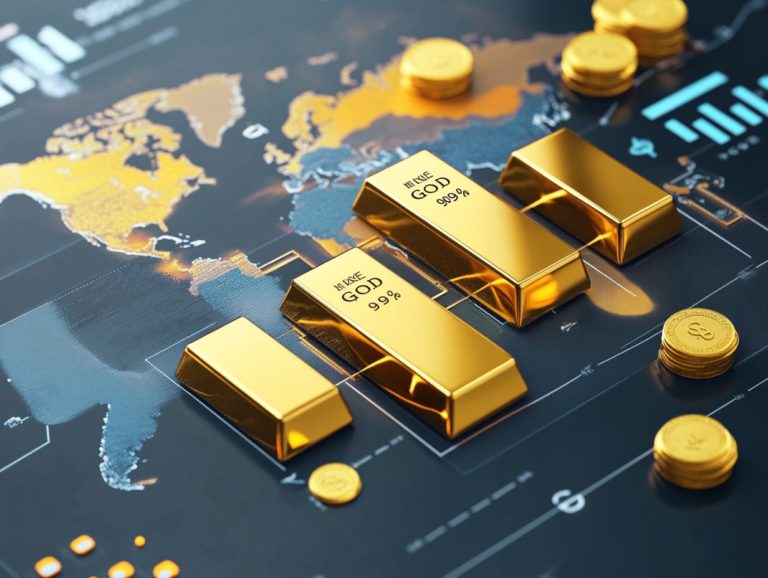Understanding the Silver Supply Chain
Let’s explore the fascinating details of the silver supply chain together! The silver supply chain is a sophisticated web that encompasses a variety of essential players, from mining companies to refiners, mints, and fabricators. Each step in the production process, from extraction to distribution, is vital in ensuring this precious metal finds its way to consumers and industries alike.
This article delves into the intricacies of the silver supply chain, examining the processes that bring silver from the earth to the marketplace. It also highlights the factors that impact its availability, including economic trends, environmental considerations, and technological advancements.
Engage with us as we unravel the dynamics that define the silver industry today.
Contents
Key Takeaways:
- The silver supply chain involves key players such as mining companies, refiners, and mints/fabricators to produce and distribute silver products.
- The production process includes mining, extraction, refining, and manufacturing, each with their own set of complexities and challenges.
- Economic and political influences, environmental concerns, and technological advancements all play a role in shaping the silver supply chain.
Overview of the Industry
The silver industry holds an important role in the global economy, featuring a complex supply chain and dynamic market forces that shape both silver supply and demand. This precious metal boasts a wide array of applications, from industrial uses to its allure as an investment, and has experienced fluctuations in production and consumption levels due to factors like economic conditions and technological advancements.
Silver is increasingly used in renewable energy technologies, especially solar panels. The landscape of silver mining and trading is evolving swiftly. If you’re interested in this sector, it’s crucial to understand silver market dynamics.
Historically, silver has been a key part of money systems and trade, often dubbed ‘the people’s metal’ because of its accessibility. For centuries, it has maintained its value not just as currency but also as a safe haven during times of economic uncertainty.
In recent years, trends within the silver industry reveal a significant shift, with industrial demand soaring especially in electronics and green technologies while investment interest remains strong, even amid fluctuating economic conditions. As sustainable practices gain traction, silver mining operations must adapt to meet rising demands while aligning with environmental standards.
This dual role of silver, serving both as an industrial staple and a sought-after investment, emphasizes its crucial role in the economy and underscores the importance of closely monitoring market trends.
Key Players in the Silver Supply Chain
The silver supply chain is a complex network, bolstered by key players, each contributing crucial roles that shape the dynamics of silver prices and availability. Mining companies are the first link, extracting silver ore, which is then refined by specialized refiners to ensure that the silver continues to flow seamlessly.
This collaboration meets both industrial demands and investment needs with precision. Mints and fabricators add value by creating final products like silver bullion and coins, while financial institutions and commercial banks are instrumental in facilitating trade flows and managing market volatility.
Understanding this intricate interplay can deepen your appreciation for the silver market and its underlying mechanisms. Stay informed about silver market trends and consider exploring more resources on the topic.
Mining Companies
Mining companies lead the charge in silver production, extracting impressive quantities from deposits in Mexico, Peru, China, and Russia top producers of this coveted metal. These organizations use advanced extraction techniques to maximize yield and efficiency while navigating the ever-changing landscape of silver prices influenced by market demand and production costs.
Beyond these primary regions, countries like Australia, Chile, and the United States play significant roles in the global silver supply. Each mining company faces its own challenges, from adhering to strict rules and regulations to keeping up with rapid technological advancements that enhance efficiency and safety.
As environmental concerns grow, companies must invest in sustainable practices to thrive. Despite these challenges, their role remains vital as they work to balance profitability and responsibility in pursuing this valuable resource.
Refiners
Refiners hold a crucial position in the silver supply chain, transforming raw silver ore into refined silver bars and other valuable forms. This intricate process requires strict adherence to regulatory requirements and efficient logistics solutions.
By doing so, they ensure the refined silver meets market demands while adhering to stringent quality standards and navigating the complexities of market dynamics.
In the evolving silver industry, you must tackle challenges like fluctuating market prices and stringent environmental regulations. Your expertise not only enhances the purity of silver but boosts its overall market value.
With a growing emphasis on ethical sourcing, it’s essential to ensure transparency throughout operations, from mining to distribution. This responsibility adds complexity, requiring effective management of supply chain logistics the management of how products are delivered to consumers while maintaining compliance with international standards.
In doing so, you reinforce your vital role in upholding the integrity of the silver market.
Mints and Fabricators
Mints and fabricators are essential to the silver supply chain, producing silver bullions and coins for both investment and collectible markets. Their operations influence silver consumption patterns, as the design and quality of minted products enhance silver’s investment appeal.
By introducing unique designs and limited-edition releases, they elevate silver’s aesthetic value and position it as an attractive option for gifting and personal use.
As consumer trends focus on sustainability and ethical sourcing, the significance of mints in ensuring responsible silver production has increased. Fabricators can adapt to evolving preferences, such as the rising interest in artisanal and crafted pieces, shaping the dynamics of the silver market.
They respond to shifting demands, reinforcing the connection between their products and today s environmentally conscious consumer.
The Process of Producing Silver
The journey to producing silver is a complex and nuanced endeavor that begins with mining and extraction. Here, valuable silver ore is sourced from deep within the earth.
This is followed by a meticulous refining and purification process that elevates the silver to the desired quality. Once refined, the silver enters the manufacturing stage, transforming into a diverse range of products.
Finally, the distribution phase ensures that this precious metal reaches its intended end-users, whether for industrial applications or investment purposes.
Mining and Extraction
Mining and extraction are crucial for silver production. You will use various techniques to extract silver ore while managing costs and understanding market demands.
Consider methods like underground mining and open-pit mining. Each technique has unique advantages and challenges.
Underground mining yields high-grade ores but can be costly. Open-pit mining is more economical for larger operations but can harm the environment.
Heap leaching is a cost-effective method for lower-grade ores, though it may risk contaminating soil and groundwater.
Keep in mind that global silver prices, operational costs, and environmental regulations will influence your methods. Adapting to these factors is essential as you strive to meet market demands while embracing sustainability.
Refining and Purification
Refining ensures the silver you extract meets high-quality standards. This process is vital for applications ranging from industrial use to investments.
You start with ore extraction, where you separate silver from other materials. After obtaining raw silver, you ll use smelting and chemical processes to purify it.
Quality control is essential at every stage. This includes testing for contaminants and evaluating purity levels.
Regulations shape these processes. By adhering to international standards, you ensure product quality and affect market dynamics.
Manufacturing and Distribution
Manufacturing and distribution represent the final stages in the silver production process. Refined silver is transformed into various products, from silver bullions to specialty items, and delivered to market.
Efficient logistics solutions are paramount to ensure these products reach consumers promptly. This transformation involves multiple steps, including casting, alloying, and stamping each essential for producing high-quality items that adhere to industry standards.
The silver market thrives on a robust distribution network, spanning channels from wholesalers to retailers, enabling a smooth flow of products.
Your effective logistics strategies do more than just facilitate swift transportation; they also minimize costs and maintain product integrity during transit. As demand fluctuates, your ability to adapt these systems becomes even more critical, highlighting the interconnectedness of manufacturing, distribution, and market responsiveness.
Factors Affecting the Silver Supply Chain
The silver supply chain is shaped by economic and political influences, environmental considerations, and technological advancements. Each of these elements plays a pivotal role in determining the dynamics of silver demand and supply.
For stakeholders in the silver industry, grasping these factors is essential; they can significantly affect market conditions, pricing, and overall investment strategies.
Understanding this intricate landscape allows you to navigate the complexities of the market with greater precision and foresight.
Economic and Political Influences
Economic and political influences play a crucial role in shaping the silver market, impacting everything from investment risks to market volatility.
As you navigate through fluctuating economic conditions, changes in government policies, and geopolitical tensions, you’ll notice how rapidly the demand and supply for silver can shift. This often affects pricing and your investment strategies.
By keeping a close eye on these variables, you can change your investment strategy to better respond to potential risks. This significantly influences the performance of the silver market. For instance, economic indicators such as inflation rates, employment figures, and global trade balances can hint at potential upswings or downturns in silver demand.
Political events be it elections, trade negotiations, or sanctions can create uncertainties that enhance silver’s allure as a safe haven.
Therefore, having a comprehensive understanding of these trends is vital for you as an investor seeking to navigate the complexities of silver investment effectively.
Environmental Concerns
Environmental concerns significantly influence how you approach silver mining and production, as regulatory requirements grow more stringent in light of sustainability demands.
The silver industry must adapt to these concerns, often harnessing technological advancements to reduce its ecological footprint while contributing to the expanding renewable energy sector.
These adaptations involve adopting innovative methods like water-efficient processes and waste recycling, which not only meet regulatory standards but also support long-term ecological balance.
Facing these challenges head-on can lead to remarkable opportunities. Key players in the sector are increasingly aligning their operations with international sustainability standards.
The industry plays a crucial role in the renewable energy landscape, particularly in solar panel and battery manufacturing, highlighting its commitment to environmentally friendly practices.
By embracing these sustainable strategies, the silver mining and production sector can cultivate prosperity while significantly minimizing its environmental impact.
Technological Advancements
Technological advancements are revolutionizing the silver mining industry, enhancing efficiency and transforming production techniques to meet your growing market demands.
By embracing new technologies, you not only increase yield but also mitigate the risks associated with fluctuations in silver supply and demand.
Automated drilling and advanced sensors are among the innovations that streamline extraction processes, enabling you to optimize operations effectively.
With data analytics and AI-driven insights, you can forecast silver trends and allocate resources more intelligently. These advancements boost productivity and contribute to safer working environments by minimizing human error.
As the market continues to evolve, adopting ongoing technology becomes essential for you to maintain a competitive edge.
Integrating sustainable practices alongside technological growth is vital, as it addresses environmental concerns while catering to the demands of eco-conscious consumers.
Frequently Asked Questions
What is the silver supply chain?
The silver supply chain refers to the process of extracting, refining, and distributing silver from its source to the end consumer. It involves various players, including mining companies, refiners, fabricators, and retailers.
How is silver mined?
Silver is typically found in underground mines or as a byproduct of other metal mining, such as copper or lead. It is extracted through a process of crushing and grinding ore, then using chemicals to separate the silver from other minerals.
What happens after silver is mined?
Once silver is extracted from the ore, it is sent to a refinery where it undergoes processes such as smelting and electrolysis, a process that uses electricity to separate metals from their ores, to purify and separate it from other impurities. From there, it may be sold to fabricators who turn it into various products for commercial or industrial use.
Who are the main players in the silver supply chain?
The main players in the silver supply chain include mining companies, refiners, fabricators, and retailers. Mining companies extract the silver from the ground, refiners purify it, fabricators turn it into products, and retailers sell it to consumers.
What factors influence the silver supply chain?
The silver supply chain is influenced by various factors. These include demand from industries like electronics and jewelry, economic conditions, political events around the world, and environmental regulations.
Fluctuations in any of these areas can impact the supply chain. This can affect the availability and price of silver.
Why is understanding the silver supply chain important?
Understanding the silver supply chain is crucial. It helps individuals and businesses make informed decisions about investing in silver and tracking market trends.
It also ensures that sourcing is ethical and sustainable. Knowing the supply chain sheds light on potential risks and opportunities in the industry.










